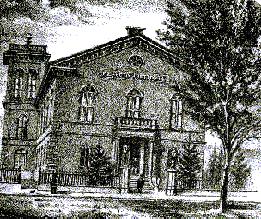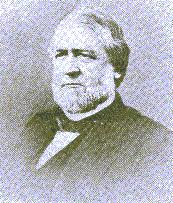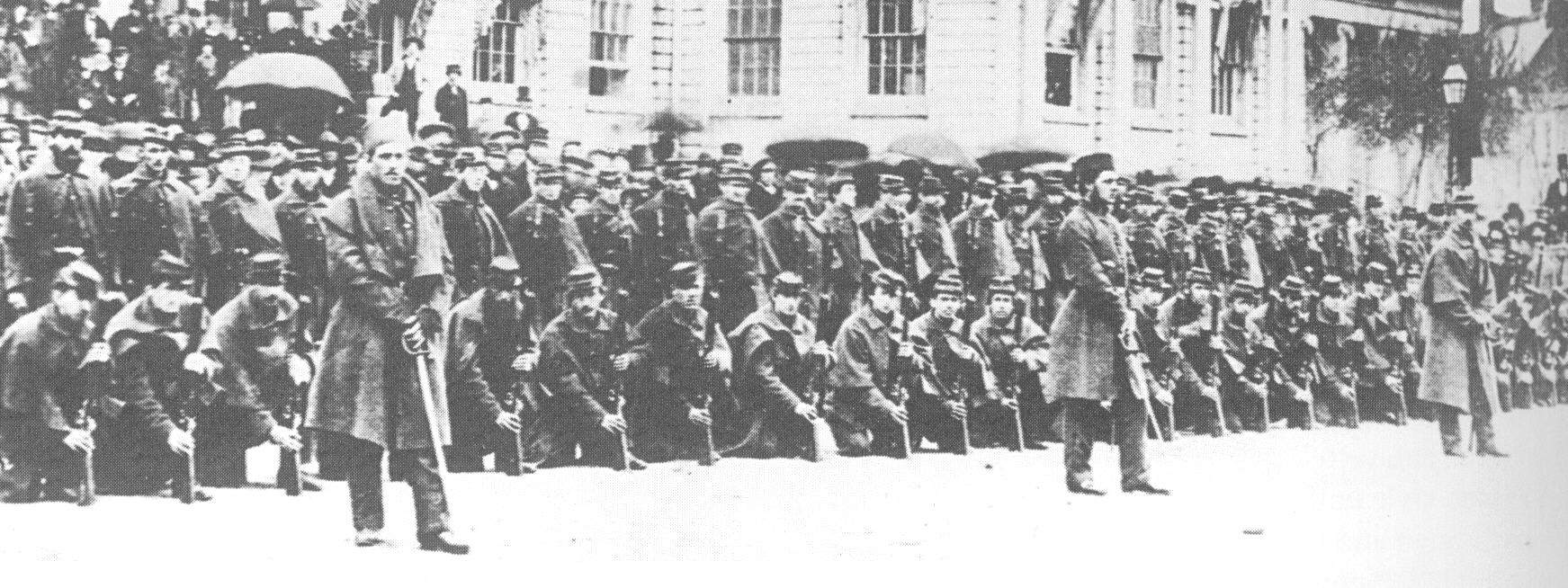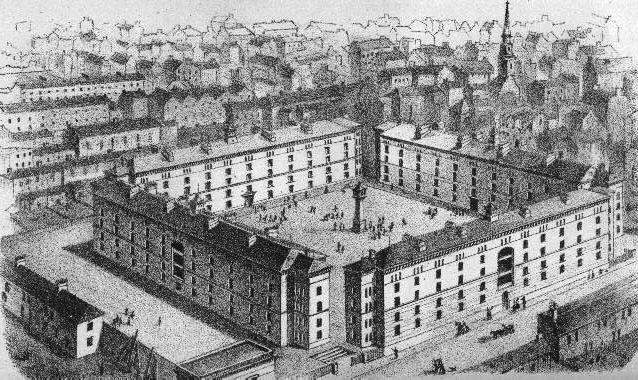Selected Verses from
NEW YEAR’S ADDRESS OF
THE CARRIERS OF THE SOUTH DANVERS WIZARD,
JAN. 1, 1864
The year is up!
Its hours have fled,
Old time his
year-glass turning,
Its passing days
are marked with red
In blood stains
of the worthy dead,
Their patriot
ardor burning.
The year is up
– the rebel strife
With scenes of
woe attended,
The wildering
din, the loss of life.
The muffled drum,
the screaming fife–
We trust are
well nigh ended.
We’ve told you
all that’s done and said
And who has done
the fighting,
The name of those
who fought and bled,
The poisoned
fangs of Copperhead
The nation’s
prospect blighting.
The entire poem is reprinted under
Literature
- Poetry.
A NEW YEAR’S GIFT
“Our population has
again been put under obligations to Mr. [George] Peabody by a munificent
donation of books, numbering 2,144 volumes… The news is proof of Mr. Peabody’s
interest in his native town, is not only gratifying for its increased means
of usefulness, but as a graceful intention that his fellow townsmen still
retain a warm place in his regards.”
(South
Danvers Wizard, 4/20/1864, p. 2/5)

Fig. 3. 3. Advertisement
|
Overview: January - July
1864
NEW YEAR’S

Fig. 3.1. The Peabody Institute, Peabody,
Mass.
The citizens of South
Danvers gathered at the Peabody Institute on Main Street to ring out 1863
with a Grand National Concert. Students in “Mr. Watts’ juvenile class”
sang patriotic songs such as “Zouaves Camp” and “When the War is Nearly
Over” and performed laughable farces entitled “The Flower of the Rebel
Army” and “The Raw Recruits.”
Four days later, crowds again visited the
Institute to attend a War Meeting. It featured the lively music of the
Salem Brass Band and patriotic speeches. Recruits signing on before
January 12 received an extra bounty from the town.
“Let Massachusetts and all other states make a New
Year’s present of their quotas to the army, and the hearts of not only
the suffering captives of Richmond, but many other loyal men, black as
well as white, all over the South, would be encouraged as they hear the
tramp of 30,000 more marching to their deliverance,” said lawyer and Peabody
Institute Trustee Alfred A. Abbott.
“To fail in this is to hold back the reserve that
is to win the battle. The prosperity of this part of the country
would depart, and we should see our land rent with civil feuds, and drenched
in fraternal blood: We are enjoying prosperity such as was never before
known in civil war. And shall we make return for this by folding
our arms, or shall we sacrifice all, our life, if may be, to the cause
of those at home. He would leave it to the wives and mothers of our
brave soldiers to say whether we should give up now. We must succeed,
for God never let anything so precious as patriot blood be lost.”

Fig. 3.2. Alfred A. Abbott.
As in many industrial
areas of the north, South Danvers was prospering in 1864. Local tanneries
imported 30,000 more hides than the year before. The Danvers Bleachery
on Foster Street was set to expand by adding dyeing and napping facilities.
The W. M. Jacobs & Son tannery announced plans to level its site near
Eagle Corner [Washington and Main streets] and build a new four-story factory.
The Eastern Railroad, which posted an 8.25 percent
increase in earnings in 1863, ran a special late train during that winter
in order to afford South Danvers citizens an opportunity to attend the
New York and Havanna Opera Troupe at the Boston Theatre. A successful
Antiquarian Supper and Levee, fairs and sleigh rides were popular, as well
as the use of laughing gas.
As the town’s prosperity grew so did the cost of
living and members of the working classes found it increasingly difficult.
The town’s vital statistics for 1863 indicate that of 150 births that year,
78 of the newborns were children of “foreign-born” parentage.
Of the 100 deaths that year, nearly half (47) were children under 8 years
of age.
By the end of January, the curriers in South Danvers
and Salem called a strike. A letter-to-the-editor signed by “Looker-On”
reads, “So far as the curriers simply ask for a rise in the price of labor,
corresponding to the rise in the price of necessaries of life, they are
clearly right; but when they attempt to dictate to their employers as to
the manner in which they shall carry on their business – what laborers
they shall employ – how many apprentices they shall have, etc. – they are
just as clearly wrong.”
The Journeyman Curriers of Salem and South Danvers were
supported early on by curriers in New York and New Jersey. By March,
the strike involved violence and intimidation.
Despite the three-month-long strike, the business of tanning
and currying continued to prosper and in April the
Wizard reported,
“The strikers are generally falling back into their old places, or going
into other business, so that street idlers are getting much more rare.”
Additionally, the strike resulted in “American workmen” filling “the places
vacated by foreigners.”
Another issue that separated the owners from the
laborers was the availability of inexpensive transportation. At town
meeting in February, citizens opposed a petition from the Eastern Railroad
to consolidate the South Reading Branch Railroad and endorsed a proposal
of the Salem and South Danvers Railroad for a charter for a road in Danvers
and for a petition for a Horse Railroad from South Danvers to Lynn.
The voters retained the right to demand the enterprise “be in the hands
of those who are identified with the local interests and business, and
will make it subservient to the prosperity of South Danvers and Lynn, and
not under the control of men or corporations who would undertake it for
speculative purposes…”
One letter-to-the-editor charged that opposition
to the proposed horse railroad route was voiced by “some six to eight men
in this town who keep a number of fancy horses, and who have but little
else to do but exercise them by driving to Salem and back two or three
times every day…Shall ninety-nine one-hundredths of the inhabitants of
the town of Danvers be put to trouble and expense daily on account of the
present impracticable mode of conveyance to Salem in order that the pleasure
and interests of some few may be gratified and enhanced?”
It was late May before the state Legislature granted
the petition to place track on Washington and Bridge streets, “in view
of running the cars to Danvers, over the main road”.
In June, the existing Horse Railroad raised its rates to six cents per
single ticket. The rate hike was justified due to the high cost of
meal, hay and upkeep for the horses. The following week, the Horse
Railroad donated a third of the fares collected to benefit soldiers in
hospitals.
Another “specimen of the rich trampling upon the
rights of the poor” arose in April, when the high price of butter placed
it out of reach of poor families. The price hike was blamed on “speculators
who have been shipping vast quantities to Europe to pay for imported gewgaws…”
A pledge was proposed for circulation among families, “whereby they agree
to abstain from the use of butter altogether, until it comes down to a
fair price.”
The spring was marked by unusual weather. Snow fell in
early April sufficient for sleighing. Tricked by the weather,
wild geese “commenced their spring campaign too early” and had to return
South. By mid-May, the temperature was near 90 degrees and
extreme heat, “up to 100 degrees in the shade” was recorded in late June.
The full moon that appeared at the end of June was so bright that residents
near Eagle Corner falsely reported the “bright light in a southwesterly
direction” as a fire.
Throughout the late spring of 1864, people in South
Danvers harbored hopeful feelings about the outcome of the war. The
Union victories in late 1863 at Vicksburg and Chattanooga, the relative
inactivity of the Army of the Potomac, and the assignment of Ulysses Grant
as Major General all added to the north’s optimism.
In February, President Abraham Lincoln called
for 500,000 more men to fill the ranks of the Union Army. The requisite
number of local men was easily found, as recorded in a Wizard editorial:
“It is now stated as a fixed fact that South Danvers is nine men short
of filling her quotas, and Danvers, forty in excess. The latter must
be a good place for those dreading a draft to live in.”
By mid-summer, the war assumed a more terrible
nature, eliciting deep despair. As the reports were received of the losses
resulting from six weeks of the bloodiest fighting, from the Wilderness
to Petersburg, the patriotic rivalry between the two towns took on a grisly
nature. The lists of recruits previously published in the paper were
replaced with lengthy lists of dead men from the towns.
A note at the bottom of the list of Danvers
men reads, “It will be seen that the above list contains the names of fifty-four
soldiers, who have been killed in battle or died while in the United States
service, this is a loss of eighteen greater than that of our neighbor town,
South Danvers, and probably larger than that of any other town in Essex
County, in proportion to its population.”
Symbolizing both the hope and weary resignation
of the townspeople towards the war is the record of MOSES SHACKLEY, JR.,
a graduate of Peabody High School. His story is recorded in the pages of
the Wizard beginning in 1861, when he joined the Army at the age
of 17.
At the town's first war meeting, Shackley's
father, a member of the committee of five selected by the townspeople
to meet the call for troops, announced that he "had already fitted out
and sent his son at an expense of fifty dollars. This allusion to
the young and patriotic Shackley ... brought down the house with deafening
applause."

Fig. 3.4. Company A, 8th Massachusetts Regiment, known
as the Salem Zouaves.
Shackley enlisted before
the onset of the war as a 3-months man with the Salem Zouaves of the Massachusetts
8th Regiment. He was on his way, he thought, to Baltimore, Maryland
to protect the Capitol. He was routed not to Baltimore, but to Annapolis
to protect Old Ironsides and was among the troops that arrived at Washington
shipyard and marched to the capitol building. In August, he made a visit
home and was reassigned as a wagoner to the Massachusetts
19th Regiment. He soon left the wagons and went into the ranks.
By September, he was stationed at Harrison's Landing on the James River
in Virginia and participated in the seven days fighting before Richmond.
He earned a Lieutenant's commission by his
bravery and participation in the bloody encounters of Ball's Bluff (Harrison's
Landing), the battles of the Peninsula, second Bull Run (Manassas), Antietam,
Fredericksburg (Marye's Heights), and at Gettysburg, where he distinguished
himself.
When a battery was disabled while under terrific
cannonading, volunteers were sought to assist in working its guns.
The Adjutant General reported, "The conduct of Second Lieutenant Moses
Shackley, who insisted on joining the volunteers, was particularly gallant
and brave, walking from piece to piece, encouraging and assisting the men."
Shackley remained with his regiment some five months
after the battle of Gettysburg, when, his well-earned rank was reduced
in what was reported as a "mean attempt to injure his reputation." He returned
to South Danvers and an editorial appeared in the Wizard in December,
1863. It reported that Shackley was absent without leave from the
Army and was discharged. "Such services in the foremost positions
in actual warfare deserve honorable mention, and its only for those who
have done more in the great cause of the country to speak in terms of disparagement,"
it read.
Twenty-year-old Shackley did not remain inactive
for long. When the call for more troops was issued in the winter of 1863,
he enlisted at a lower grade in the 59th Veteran Corps, and, under generals
Burnside and Gould, he fought safely at the Wilderness and was mortally
wounded in the Bloody Angle at Spottsylvania Court House on May 12, 1864.
He died the next morning at the camp hospital.
“Of all who have gone out from us, few have
fought so many battles and encountered so many perils, and at the same
time endured the fatigues of the camp as cheerfully as our departed friend
and townsman,” read the editor’s note preceding the article that appeared
in the Wizard on June 1.
Another loss felt by the town was the death
of local author NATHANIEL HAWTHORNE in May. An obituary by “H.D.J.”
appeared in the Wizard. The author reported that “[We/I] have
listened with admiration to his sublime and instructive conversation.
He was mentally sensitive in the extreme. He never seemed to appreciate
the great power of his own genius.”
Hawthorne’s career and writing was a topic
of continued coverage in the Wizard. Editor Fitch Poole, Jr.
reviewed Hawthorne’s book “Marble Faun” in a May 1860 issue of the paper.
A report penned by Hawthorne and providing an account of the battle of
the ironclads, the Monitor and the Merrimac, appeared in the Wizard
in July 1862.
Since its inception, it was a habit of the
Wizard
to
feature all news published about GEORGE PEABODY, the town’s benefactor.
The town received news in late January that “the trustees of Mr. George
Peabody’s munificent gift of 150,000 to the poor of London, have decided
to appropriate the fund, or the large part of it, to the erection of buildings
in suitable localities to furnish lodgings for the poor. One of the
proposed buildings has already been finished, and the lodgings are about
to be let. It is four stories high covering an area of 30,000 square
feet. It contains, besides stores upon the street…”

Fig. 3. 5. Peabody Square, Islington, London.
The following month, the
Wizard
reported that “Five hundred thousand dollars of the Coast Defence scrip
of Massachusetts has been taken by George Peabody, of London, at $110.”
In late spring, the Wizard reported
that George Peabody donated $500 to the Baltimore Sanitary Fair.
A month later, Peabody announced he would retire in October from George
Peabody and Company.
Much of his time was occupied with plans
for the Peabody Donation Fund, “for the benefit of the industrious poor”.
Eventually, the endowment became the Peabody Education Fund, which directed
its efforts to provide education in the southern United States.

Fig. 3. 6 Peabody Fund Commission - Admiral [David]
Farragut, George Peabody, Hamilton Fish,
General [Ulysses] Grant, Governor Aiken, S.C., Robert
Winthrop, Samuel Wetmore
1. “Another War Meeting.”
South Danvers Wizard
6 Jan. 1864: 2.
2. “Grand National Concert.”
South Danvers Wizard
6 Jan. 1864: 2.
3. “New Dye House.” South Danvers Wizard 9 Mar.
1864: 2.
4. “Improvements.” South Danvers Wizard 1 Jun.
1864: 2.
5. “Amusements in Boston.”
South Danvers Wizard
13 Jan. 1864: 3.
6. “Laughing Gas.”
South Danvers Wizard
2 Mar. 1864: 2.
7. “Births, Marriages, and Deaths in South Danvers
in 1863.” South Danvers Wizard 17 Feb. 1864: 2.
8. “The Strike.” South Danvers Wizard 27 Jan.
1864: 2.
9. “Assault and Battery.”
South Danvers Wizard
9 Mar. 1864: 2.
10. “Tanning and Currying.”
South Danvers Wizard
13 Apr.1864: 2.
11. “Town Meeting.” South Danvers Wizard 3 Feb.1864:
2.
12. “Danvers vs. Horse Railroad.”
South Danvers Wizard
17
Feb.1864: 2.
13. “The Horse Railroad Hearing.” South Danvers Wizard
15 May 1864: 2.
14. “Fare Raised.” South Danvers Wizard 1 Jun.
1864: 2.
15. “Soldiers’ Aid.” South Danvers Wizard 8 Jun.1864:
2.
16. “Butter Pledge.” South Danvers Wizard 13 Apr.
1864: 2.
17. “Sleighing in April.”
South Danvers Wizard 13
Apr.1864: 2.
18. “Wild Geese.” South Danvers Wizard 13 Apr.
1864: 2.
19. “Alarm of Fire.” South Danvers Wizard 22 Jun.
1864: 2. |

